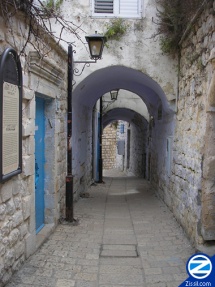Old City Safed
The Old City of Tzfat is a unique neighborhood with a deep history and a diverse population. New residents will find that purchasing property in the Old Jewish Quarter brings challenges that are not faced by real estate deals in other parts of the world.
Contents |
[edit] History
The modern Jewish settlement of Tzfat dates back to the 16th century when many Jews, fleeing the Inquisition and Exile of Spain and Portugal, joined the existing Jewish community in Tzfat. They built their homes along the mountain slope above the ancient cemetery. These homes were buried twice during earthquakes, in 1759 and again in 1837. Survivors build new homes on the still-standing ruins of these old homes.
[edit] Tabu
The families that owned property in Tzfat held “tabu” under Ottoman and subsequent British law. This indicated that the family owned the property. When the Jewish National Fund (JNF) began to purchase property in Palestine in 1901 they then leased these properties to the new owners, including kibbutzim and home owners. Until today, there are only a few areas in Israel where land ownership is still registered by tabu, including the Old City of Tzfat. All other land and real estate purchases are conducted through 99-year renewable leases, as established by the JNF.
[edit] Implications
For people who wish to buy property in Tzfat, the laws of tabu mean that they must somehow trace the original owners of a property in order to purchase it. Ownership of many properties is legally held by dozens, if not hundreds, of descendants of the original owner. Many new owners do succeed in tracking down the legal owners of properties in the Old Jewish Quarter and others are able to complete a purchase through a real estate agent.
[edit] Excavations
Although many of these properties are built on top of the ruins of the Old City homes, it is not common for owners to attempt to dig out the hundreds-years-old homes. The digging process itself is labor-intensive and many of these structures have problems with leakage and dampness which cannot be solved easily. In addition, adding electrical lines and plumbing lines to these old homes is difficult and costly.
Nevertheless, many stories are told of local residents who can peek under their floorboards and see a “basement” that is very old. Other residents are surprised when a crack in a wall or floor opens into a new underground room. Some people do manage to renovate these old structures.
[edit] Old City Development
Since the 1980s many newcomers to Tzfat have contributed to the development of the Old City. They track down original owners and purchase properties, oftentimes adding on additions to small existing homes. Real estate agents also purchase properties to develop and sell as new homes.
[edit] Community
The Old Jewish Quarter was once divided into Sepharadic (the older area) and Ashkanazi communities but today the Old City of Tzfat is a mixed area. Sepharadic and Ashkanazic Jews live side-by-side. The majority of the community is Orthodox, but within that definition exist both ultra-Orthodox and moderate-Orthodox Sephardic and Ashkanazic Jews, Religious Zionists and a variety of Hassidic groups including the Sanz and Breslev Hassidic Housing “villages.” There is a population of non-religious Jews in the Old City, though their numbers are quite small.
There are many new immigrants living in the Old City, including several hundred English-speaking residents. Some of these English-speakers belong to the aforementioned communities while others are unaffiliated.
| |||||||||||
| |||||||||||||||||
| ||||||||||||||


